NASA has set a target date of September 2004 for when the first space shuttle will launch since the Columbia disaster. The agency was originally targeting earlier in the year, but they felt they needed more time to develop tracking and repair systems to fulfill the safety requirements suggested by the Columbia accident investigation. The improvements include new camera systems to watch the shuttle launch, a way for the astronauts to repair damage while they’re in space, and modifications to the external fuel tank to prevent foam from hitting the shuttle in launch. The next shuttle to launch will likely be Atlantis.
Hubble Mosaic of the Sombrero Galaxy
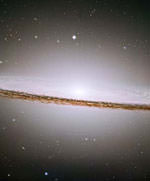
Image credit: Hubble
The newest image from the Hubble Space Telescope is of the Sombrero Galaxy, which was pieced together from a mosaic of six images taken by Hubble’s Advanced Camera for Surveys. The Sombrero Galaxy is quite large; visually it’s one-fifth the size of the Moon in a telescope. This release marks the fifth anniversary of the Hubble Heritage Project, which uses telescope time to release beautiful astronomy images to the public.
The Hubble Heritage Team of astronomers, who assemble many of the NASA Hubble Space Telescope’s most stunning pictures, is celebrating its five-year anniversary with the release of the picturesque Sombrero galaxy. One of the largest Hubble mosaics ever assembled, this magnificent galaxy is nearly one-fifth the diameter of the full moon. The team used Hubble’s Advanced Camera for Surveys to take six pictures of the galaxy and then stitched them together to create the final composite image. The photo reveals a myriad of stars in a pancake-shaped disk as well as a glowing central bulge of stars.
Since its inception in 1998, the Hubble Heritage Project has released more than 65 images of dazzling celestial objects, including planets, dying stars, regions of star formation, clusters of stars, individual galaxies, and even clusters of galaxies. This has been done on a monthly basis.
The Heritage team of Space Telescope Science Institute astronomers and image processing specialists selects images from the Hubble Space Telescope’s public data archive. This database contains approximately 500,000 raw images taken over the past 13 years. Although astronomers use Hubble to photograph numerous celestial objects, those results are usually shared with only the astronomical community. The Heritage team periodically combs the archive looking for interesting, but unreleased, pictures to become Heritage image candidates.
“Some of the photogenic objects that have been scientific targets often lack sufficient exposure across a range of colors,” explains Keith Noll, the Heritage lead scientist. “In other archival images the telescope’s field of view only covers a small, unrecognizable portion of the object, so we have to fill in the rest.”
The Hubble Heritage Project has been granted a small amount of observing time to essentially “fill in the gaps” in these images. The Heritage astronomers also seek visually interesting objects in the universe that have not yet been selected for Hubble scientific observations. For the Sombrero galaxy, the Heritage program devoted a number of orbits to complete a photo mosaic of the object.
Public visitors to the Heritage website (http://heritage.stsci.edu) have also been invited to help select attractive astronomical targets. One overwhelming choice of the voters was the famous Horsehead Nebula in the constellation Orion the hunter.
The Heritage program has been recognized for its contribution to inspiring the public with some of the most photogenic images ever produced in astronomy. Recent achievements for the team include the Astronomical Society of the Pacific 2003 Klumpke-Roberts award for “outstanding contributions to the public understanding and appreciation of astronomy.” In 2002, two Heritage images were selected in the Rochester Institute of Technology’s “Images From Science” traveling gallery exhibit. Several images have been selected by the US and UK postal systems. In 2000, a first-class US postage stamp showing the Ring Nebula was one of five Hubble images selected to be part of a commemorative series of stamps honoring astronomer Edwin P. Hubble.
Hubble’s new Advanced Camera for Surveys, and eventually the planned Wide Field Camera 3, promise to give the Heritage team an opportunity to share with the public even more opulent views of our colorful universe.
Original Source: Hubble News Release
Orbital Wins Air Force Launch Contract
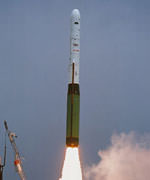
Image credit: Orbital
Orbital Sciences announced on Thursday that they have been given an $11 million contract by the US Air Force to launch a classified satellite payload on a Minotaur rocket. Three other payloads are currently scheduled to launch on Minotaur rockets, which are rebuilt Minuteman ICBMs for the first and second stages, and then the third and fourth stages are from a Pegasus XL rocket. The launch is scheduled for 2005.
Orbital Sciences Corporation (NYSE: ORB) announced today that the U.S. Air Force has exercised an option order for a Minotaur space launch vehicle under the 10-year Orbital/Suborbital Program-2 (OSP-2) contract that was awarded to the company earlier this year. The Minotaur order is the first to be placed under the OSP-2 contract, which is valued at up to $475 million over 10 years on an indefinite delivery/indefinite quantity basis. The new order increases the launch manifest for the Minotaur program to four missions to be carried out over the next two years. This most recent Minotaur space launch vehicle ordered by the Air Force is scheduled to launch a classified payload in 2005. In addition, Orbital is currently under firm contract to carry out three other Minotaur missions, including N-FIRE and XSS-11, both of which are scheduled to be launched in 2004, and COSMIC, scheduled for launch in 2005.
?We are very pleased to have the opportunity to conduct cost-effective military space missions for the Department of Defense,? said Mr. Ron Grabe, Orbital?s Executive Vice President and General Manager of its Launch Systems Group. ?The Minotaur program represents an efficient use of government assets and commercial technology to provide low-cost, operationally responsive and reliable launch services for U.S. government customers.?
Orbital originally developed the four-stage Minotaur rocket under the Air Force’s OSP-1 contract, which was awarded to the company in 1997. The Minotaur vehicle uses government-supplied Minuteman II rocket motors that serve as the vehicle?s first and second stages. The rocket?s third and fourth stages, as well as its guidance and control system, use technology from Orbital’s highly reliable Pegasus XL commercial rocket program.
Orbital has carried out two previous Minotaur missions, both of which were fully successful. In January 2000, Minotaur made its successful debut with the launch of the JAWSAT spacecraft. Later in 2000, the second Minotaur rocket successfully launched the MightySat-II satellite into low-Earth orbit. Both missions were conducted from launch facilities at Vandenberg Air Force Base (VAFB), CA.
Over the past several years, Orbital has experienced rapid growth in its launch vehicle programs for military space and missile defense-related missions. The company?s launch vehicle business is primarily centered at Orbital?s engineering and production facility in Chandler, AZ, where the company employs approximately 800 people. Orbital also maintains launch vehicle assembly, integration and test facilities at VAFB, where the company employs nearly 100 people.
Original Source: Orbital News Release
Cassini Confirms General Relativity
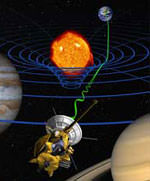
Image credit: NASA/JPL
The Cassini spacecraft has provided a group of Italian researchers with data that confirms Einstein’s general theory of relativity with 50 times more accuracy than before. They measured the frequency shift of radio waves traveling to and from the spacecraft as they went by the Sun. They measured how much the Sun’s gravity bent the radio signals and increased their travel times. Precise measurements are important because there might be a point at which general relativity stops predicting the interactions of gravity. Cassini is expected to reach Saturn on July 1, 2004.
An experiment by Italian scientists using data from NASA’s Cassini spacecraft, currently en route to Saturn, confirms Einstein’s theory of general relativity with a precision that is 50 times greater than previous measurements.
The findings appear in the Sept. 25 issue of the journal Nature. They are part of a scientific collaboration between NASA and the Italian Space Agency. The experiment took place in the summer of 2002, when the spacecraft and Earth were on opposite sides of the Sun separated by a distance of more than 1 billion kilometers (approximately 621 million miles).
Researchers observed the frequency shift of radio waves to and from the spacecraft as the waves passed near the Sun. They precisely measured the change in the round-trip light time of the radio signal as it traveled close to the Sun. The round-trip light time is the time it takes the signal transmitted from the Deep Space Network station in Goldstone Calif., to the spacecraft on the other side of the Sun and back traveling at the speed of light.
“The scientific significance of these results is the important confirmation of the theory of general relativity and the agreement with Einstein’s formulations to an unprecedented experimental accuracy,” said Sami Asmar, manager of the Radio Science Group, which acquired the data for this experiment at NASA’s Jet Propulsion Laboratory in Pasadena, Calif. “The technological significance of the experiment is the ability to overcome the harsh solar environment on radio links.”
The researchers measured how much the Sun’s gravity bent an electromagnetic beam, in this case the radio signal transmitted by the spacecraft and received by the ground stations.
According to the theory of general relativity, a massive object like the Sun causes space-time to curve, and a beam of radio waves (or light) that passes by the Sun has to travel further because of the curvature. The extra distance that the radio waves travel from Cassini past the Sun to the Earth delays their arrival; the amount of the delay provides a sensitive test of the predictions of Einstein’s theory. Although deviations from general relativity are expected in some cosmological models, none were found in this experiment.
Tests of general relativity have important cosmological implications. The question is not whether general relativity is true or false, but at which level of accuracy it ceases to describe gravity in a realistic way.
Past tests of general relativity confirmed Einstein’s prediction to an accuracy of one part per thousand. This accuracy was achieved back in 1979 using the Viking landers on Mars. The Cassini experiment confirmed it to an accuracy of 20 parts per million. The key to this improvement has been the adoption of novel technologies in space telecommunications.
The experiment could not have been conducted to this level of accuracy in the past because of noise on the radio link introduced by the solar corona. With the Cassini experiment, this hindrance was overcome by fitting the spacecraft communication system with multiple links at different frequencies. This new capability on the Cassini spacecraft and on the 34-meter (112 foot) diameter antenna at Goldstone, allowed scientists to remove the effects of the interplanetary and solar plasma from the radio data. In addition, the noise from Earth’s atmosphere was strongly reduced by special equipment installed at the Goldstone complex. These technological breakthroughs developed for the Cassini mission have led to unprecedented accuracies in the velocity measurements with benefits for future scientific experiments as well as deep space navigation.
The experiments are part of a series of radio science experiments planned for the cruise phase of the mission, including the search for low frequency gravitational waves.
Cassini will begin orbiting Saturn on July 1, 2004, and release its piggybacked Huygens probe about six months later for descent through the thick atmosphere of the moon Titan.
Cassini-Huygens is a cooperative mission of NASA, the European Space Agency and the Italian Space Agency. JPL, a division of Caltech, manages the mission for NASA’s Office of Space Science, Washington, D.C. Authors of the Nature paper, “A New Test of General Relativity With the Cassini Space Mission,” are Dr. Bruno Bertotti of the University of Pavia, Italy; Dr Luciano Iess of the University of Rome “La Sapienza”, Italy; and Dr. Paolo Tortora of the University of Bologna, Italy.
Original Source: NASA/JPL News Release
Astronomers Peer Through Titan’s Clouds
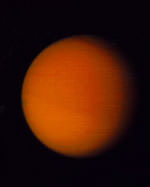
Image credit: NASA
Astronomers from Cornell university have used the Arecibo radio telescope to peer through the thick clouds on Titan, Saturn’s largest moon. The radar signatures on the surface of Titan seem to indicate a liquid surface; although, the researchers say the signals could also mean smooth solid surfaces too. More answers will come next year when the Huygens probe carried by the Cassini spacecraft will drop through the clouds and send back information about the surface of Titan.
The smog-shrouded atmosphere of Titan, Saturn’s largest moon, has been parted by Earth-based radar to reveal the first evidence of liquid hydrocarbon lakes on its surface. The observations are reported by a Cornell University-led astronomy team working with the world’s largest radio/radar telescope at the National Science Foundation’s (NSF) Arecibo Observatory.
The radar observations, reported in the journal Science on its Science Express Web site (Oct. 2, 2003), detected specular — or mirrorlike — glints from Titan with properties that are consistent with liquid hydrocarbon surfaces. Cornell astronomer Donald Campbell, who led the observation team, does not rule out that the reflections could be from very smooth solid surfaces. “The surface of Titan is one of the last unstudied parcels of real estate in the solar system, and we really know very little about it,” he says.
The observations were made possible by the 1997 upgrade of the telescope’s 305-meter (1,000 feet) diameter dish, which has greatly increased the sensitivity of what was already the world’s most powerful radar system. The observatory is managed by the National Astronomy and Ionosphere Center (NAIC), based at Cornell in Ithaca, N.Y., which has been operating the huge telescope for the NSF since 1971.
Campbell, who is associate director of NAIC as well as a Cornell professor of astronomy, notes that for more than two decades astronomers have speculated that the interaction of the sun’s ultraviolet radiation with methane in Titan’s upper atmosphere — photochemical reactions similar to those that cause urban smog — could have resulted in large amounts of liquid and solid hydrocarbons raining onto Titan’s frigid surface (minus 290 degrees Fahrenheit, or minus 179 degrees Celsius). Campbell explains that radar signals would specularly reflect — or glint — from liquid surfaces on Titan, similar to sunlight glinting off the ocean. Although Titan’s underlying surface is thought to be water ice, the complex chemistry in the upper atmosphere might have resulted in the icy surface being at least partly covered in liquid ethane and methane and solid hydrocarbons, says Campbell. One class of the solid hydrocarbons, often referred to as Titan tholins, was artificially created in a campus laboratory by a team led by the late Cornell astronomer Carl Sagan.
Titan, which is about 50 percent larger than the Earth’s moon, is the only satellite in the solar system with a dense atmosphere. This atmosphere is transparent to radio/radar waves and partially transparent at short infrared wavelengths but is opaque at visible wavelengths.
The observations were made in November and December of both 2001 and 2002. The radar signal takes 2.25 hours to travel to Titan and back. The Arecibo radar operates at a 13-centimeter wavelength (2,380 megahertz), and the transmitted power is close to one megawatt (the equivalent of about 1,000 microwave ovens). Both the Arecibo telescope and the NSF’s new 100-meter Robert C. Byrd Green Bank Telescope were used to receive the extremely weak radar echoes.
Next summer, NASA’s Cassini spacecraft, launched in 1997, is scheduled to go into orbit around Saturn and its moons for four years. The piggybacking Huygens probe is scheduled to plunge into the hazy Titan atmosphere and land on the moon’s surface.
On Campbell’s team for the Arecibo radar observations of Titan were Gregory Black, the University of Virginia; Lynn Carter, Cornell graduate student; and Steven Ostro, Jet Propulsion Laboratory.
The Arecibo Observatory part of NAIC which is operated by Cornell University under a cooperative agreement with the NSF. NASA provides partial support for Arecibo’s planetary radar program. The Robert C. Byrd Green Bank Telescope is part of the National Radio Astronomy Observatory, an NSF supported institution operated under cooperative agreement by Associated Universities Inc.
Original Source: Cornell News Release
Huge Iceberg Breaks Away from Antarctica
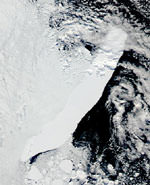
Image credit: NASA
NASA satellites have been watching a gigantic iceberg as it disrupts the fragile Antarctic marine environment. The iceberg, named C-19, is 32 km wide and 200 km long; it broke off the Ross Ice Shelf back in May 2002. The problem is that the iceberg stopped winter sea ice from moving out of the Ross Sea region. Phytoplankton, which needs sunlight, was reduced by 90%, and so the rest of the ecosystem suffered too. The iceberg is being watched with NASA’s Terra and OrbView2 satellites.
NASA satellites observed the calving, or breaking off, of one of the largest icebergs ever recorded, named “C-19.”
C-19 separated from the western face of the Ross Ice Shelf in Antarctica in May 2002, splashed into the Ross Sea, and virtually eliminated a valuable food source for marine life. The event was unusual, because it was the second-largest iceberg to calve in the region in 26 months.
Over the last year, the path of C-19 inhibited the growth of minute, free-floating aquatic plants called phytoplankton during the iceberg’s temporary stopover near Pennell Bank, Antarctica. C-19 is located along the Antarctic coast and has diminished little in size. Since phytoplankton is at the base of the food chain, C-19 affects the food source of higher-level marine plants and animals.
Kevin R. Arrigo and Gert L. van Dijken of Stanford University, Stanford, Calif., used chlorophyll data from NASA’s Sea-viewing Wide Field-of-view Sensor (SeaWiFS). The instrument, on the OrbView-2 satellite, also known as SeaStar, was used to locate and quantify the effects of C-19 on phytoplankton. The researchers were able to pinpoint iceberg positions by using images from the Moderate Resolution Imaging Spectroradiometer (MODIS), an instrument aboard NASA’s Terra and Aqua satellites. The findings from this NASA-funded study appeared in a recent issue of the American Geophysical Union’s Geophysical Research Letters.
C-19 is about twice the size of Rhode Island. When it broke off the Ross Ice Shelf, the iceberg was 32 km (almost 20 miles) wide and 200 km (124 miles) long. It was not as large as the B-15 iceberg that broke off of the same ice shelf in 2001 but among the largest icebergs ever recorded.
Since it was so large, C-19 blocked sea ice from moving out of the southwestern Ross Sea region. The blockage resulted in unusually high sea-ice cover during the spring and summer. Consequently, light was blocked. Phytoplankton blooms that occur on the ocean surface were dramatically diminished, and primary production was reduced by over 90 percent, relative to normal years.
Primary production is the formation of new plant matter by microscopic plants through photosynthesis. Phytoplankton is at the base of the food chain. If they are not able to accomplish photosynthesis, all organisms above them in the food chain will be affected. “Calving events over the last two decades indicate reduced primary productivity may be a typical consequence of large icebergs that drift through the southwestern Ross Sea during spring and summer,” Arrigo said.
Arrigo and van Dijken also used imagery from the Defense Meteorological Satellite Program (DMSP) satellite Special Sensor Microwave Imager and Scanning Multichannel Microwave Radiometer, managed by the U.S. Department of Defense. The data was used to monitor the impact of C-19 on the movement of sea ice. The data is archived at the National Snow and Ice Data Center, University of Colorado, Boulder.
Arrigo said most of the face of the Ross Ice Shelf has already calved. There is another large crack, but it is very difficult to predict if and when another large iceberg will result.
NASA’s Earth Science Enterprise is dedicated to understanding the Earth as an integrated system and applying Earth System Science to improve prediction of climate, weather, and natural hazards using the unique vantage point of space.
Original Source: NASA News Release
Twin Telescopes Peer at Distant Galaxy
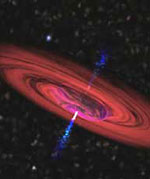
Image credit: NASA/JPL
Two linked telescopes at the W.M. Keck Observatory on Hawaii’s Mauna Kea took a good look at galaxy NGC 4151 in the infrared spectrum. Located 40 million light years from Earth, NGC 4151 has been well studied by telescopes in various wavelengths, but this is the most detailed infrared image produced. The Keck interferometer works by combining the light from two 10-metre telescopes to create a virtual telescope that’s the equivalent of an 85-metre telescope.
A galaxy far beyond our own Milky Way, with a monstrous, churning black hole in its center, has been observed by two optical telescopes working in unison as an interferometer. These observations reveal the finest level of detail in a galaxy ever produced at infrared wavelengths.
Two linked telescopes at the W.M. Keck Observatory on Mauna Kea, Hawaii, observed the inner regions of the galaxy NGC 4151. The Keck Interferometer combines the world’s two largest optical telescopes. A paper on the findings will appear in the October 20 issue of the Astrophysical Journal Letters.
NGC 4151 is 40 million light years from Earth, far beyond the most distant object previously detected by this type of telescope system, which was about 3,000 light years from Earth. These observations marked the first time an optical/infrared interferometer detected any object outside our galaxy and were followed a few weeks later by observations of a second galaxy with the European Southern Observatory’s Very Large Telescope Interferometer.
“This opens a whole new area of research on galaxies other than our own,” said Dr. Rachel Akeson, an astronomer at the Michelson Science Center at the California Institute of Technology in Pasadena. The Keck Interferometer, with its 10-meter (33-foot) telescopes, has the sensitivity needed to detect objects outside our galaxy.
The Keck Interferometer gathers light waves with two telescopes, then combines the waves so they interact, or “interfere” with each other. The system transports the light to a laboratory located between them, where a beam combiner and infrared camera combine and process the light. This technique simulates a much larger, more powerful telescope. In this respect, the Keck Interferometer is equivalent to an 85-meter (279-foot) telescope.
“Interferometry provides the angular resolution, or ability to resolve fine details, to make these kinds of observations,” said the interferometer system architect, Dr. Mark Colavita of NASA’s Jet Propulsion Laboratory, Pasadena, Calif.
“We couldn’t observe objects as faint as this galaxy before with an interferometer.” Adaptive optics on 10-meter telescopes provides the sensitivity to make this observation,” said Dr. Peter Wizinowich, interferometer team lead for the W.M. Keck Observatory at the California Association for Research in Astronomy, Kamuela, Hawaii.
NGC 4151, well studied with telescopes and instruments at many wavelengths, is believed to have a black hole at its center surrounded by a doughnut-shaped ring of dust.”The black hole is estimated to be 10 million times as massive as our Sun, and 10 times more massive than the black hole at the center of our own galaxy, the Milky Way. Like all black holes, its gravitational pull is so powerful that nothing, not even light, can escape. However, as it gobbles up nearby material, a fraction of the material is spit out in a jet.
“We’re interested in studying galaxies with massive black holes,” said Dr. Mark Swain, a JPL astronomer and lead author of the paper. “We found that emission in NGC 4151 was unexpectedly compact. This indicates the light we saw is likely coming from a disc of material falling into the massive black hole.”
The observations were made on May 19 and 20, 2003, by a team of scientists from JPL, the California Association for Research in Astronomy, and the Michelson Science Center. Akeson, Colavita, Swain and Wizinowich are part of the team.
The Keck Interferometer is part of NASA’s Origins Program, which seeks to answer the questions: Where did we come from? Are we alone? The development of the Keck Interferometer is managed by JPL for NASA’s Office of Space Science, Washington, D.C. JPL is a division of the California Institute of Technology. The W.M. Keck Observatory is funded by Caltech, the University of California and NASA, and is managed by the California Association for Research in Astronomy, Kamuela, Hawaii.
Original Source: NASA/JPL News Release
ESA Chooses Designers for New Mars Missions
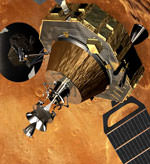
Image credit: ESA
Three European firms have won contracts to design the European Space Agency’s ExoMars spacecraft – a mission that is expected to launch to the Red Planet in 2009. ExoMars will consist of an orbiter and a rover that will land on Mars, and explore some of its surface. The three winning teams are Alenia Spazio, Alcatel Space and EADS Astrium. Teams have also been selected to provide design studies for the Mars Sample Return mission – where a spacecraft will land on Mars, collect samples, and then return them to Earth.
A major milestone in ESA?s long-term Aurora programme of Solar System exploration has been passed with the announcement of the winners of competitive contracts for two of the programme?s key robotic missions ? ExoMars and Earth re-entry Vehicle Demonstrator (EVD).
A major milestone in ESA?s long-term Aurora programme of Solar System exploration has been passed with the announcement of the winners of competitive contracts for two of the programme?s key robotic missions ? ExoMars and Earth re-entry Vehicle Demonstrator (EVD).
Alenia Spazio (Italy), Alcatel Space (France) and EADS Astrium (France) are heading the three industrial teams selected to carry out a full mission design for ExoMars, the Aurora exobiology mission to Mars.
At the same time, two industrial teams, headed by EADS LV (Launch Vehicles) of France and Surrey Satellite Technology Limited (SSTL) of the United Kingdom respectively, have been selected for the pre-development phase (officially known as Pre-Phase A) of the EVD mission.
?Following the Invitations To Tender (ITTs) for these contracts, issued in April-May 2003, there was an overwhelming and enthusiastic response from industry,? said Bruno Gardini, Aurora Project Manager.
?We were delighted by the number and the excellence of the proposals received,? he added. ?It was also pleasing to see that many of them included new, innovative ideas from industry.?
ExoMars
The ExoMars mission, to be launched in 2009, is the first of the major Flagship missions in the Aurora programme. It includes an orbiter and a descent module that will land a large (200 kg), high-mobility rover on the surface of Mars. After delivery of the lander/rover, the ExoMars orbiter will also operate as a data relay satellite between the Earth and the vehicle on the Martian surface.
The primary objective of the ExoMars rover will be to search for signs of life, past or present, on the Red Planet. Additional measurements will be taken to identify potential surface hazards for future human missions, to determine the distribution of water on Mars and to measure the chemical composition of the surface rocks.
Three parallel Phase A studies for the ExoMars Mission will be carried out by industrial teams that include companies from ESA member states and Canada:
- * Alenia Spazio (Italy) with subcontractors OHB (Germany), GMV (Spain), SEA (UK), SSC (UK) and Laben (Italy).
- * Alcatel Space (France) with subcontractors Deimos (Spain), ETCA (Belgium), Fluid Gravity Engineering (UK), Kayser Threde (Germany), Laben (Italy), MD Robotics (Canada), NGC Aerospatiale (Canada), QinetiQ (UK), Vorticity (UK).
- * EADS Astrium (France) with subcontractors Astrium Ltd. (UK), EADS LV (France) and SAS (Belgium).
The contracts cover the design of the entire ExoMars mission, from launch, through the long interplanetary voyage to the landing of the rover on the planet.
?This is an exciting landmark for the Aurora programme, since these are the first contracts dedicated to mission development rather than technical studies,? said Gardini.
?With the participation of all major European aerospace companies, the proposed concepts will make the best use of their extensive experience, gathered over many years, in the design and development of interplanetary missions,? he said.
?The studies will also bring to fruition several years of efforts from national and international programmes in investigating and planning Mars missions.
?From the quality of the proposals, the agency is very confident that the technical baseline will be fully consolidated by the end of the Phase A studies and that the spacecraft design will then be defined to a level of detail commensurate with a prompt start of Phase B.?
Depending on the availability of funding, the Phase B studies for ExoMars are planned to start in 2004.
Earth re-entry Vehicle Demonstrator (EVD)
The second Aurora Flagship mission is a Mars Sample Return (MSR), planned for 2011. Its main goal will be the retrieval of rock samples from the Martian surface and subsurface for subsequent analysis in laboratories on Earth.
In order to ensure the success of this challenging mission, a number of new technologies will have to be developed and tested. Conceived as a small, technology-driven Arrow-class mission, the Earth re-entry Vehicle Demonstration will be used to validate the design of the small MSR capsule that will bring back the precious samples of Martian soil.
The EVD is expected to be launched in 2007. The baseline mission foresees the insertion into a highly elliptical Earth orbit of a small spacecraft carrying a re-entry capsule. In order to reproduce the final phase of a typical Mars return mission, the capsule will then carry out a ballistic re-entry into Earth?s atmosphere at speeds of up to 45,000 km/h.
Two industrial teams have been selected for the parallel EVD mission Pre-Phase A studies. The concept presented by the industrial team, under the leadership of EADS LV (France) with the participation of OHB System (Germany) and Plansee (Austria) is solidly based on the experience of past projects.
The industrial team led by SSTL (UK), a company well known for its experience in small highly integrated spacecraft, has devised a very innovative concept well adapted for a small technology mission. The participation of highly specialised companies, Fluid Gravity Engineering (UK), Kayser Threde GmbH (D) and Vorticity Ltd. (UK) ensures an excellent coverage of the mission?s most critical technologies.
?The expectations are for highly competitive and exciting Pre-Phase A studies,? said Gardini.
The next Aurora contract for Phase A studies will concern the Mars Sample Return mission. Industrial proposals were submitted on 1 August and the evaluation is nearly completed. The names of the selected companies are expected to be announced in early October.
Original Source: ESA News Release
10,000 New Images of Mars
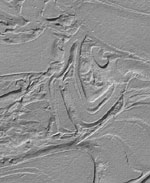
Image credit: NASA/JPL
NASA has released 10,232 new images of the Red Planet taken by the Mars Global Surveyor spacecraft, including wind whipped polar dunes, steep-walled valleys, and boulder-strewn terrain. The images were taken over the course of several months, from August 2002 to February 2003, and they include views all over the planet. This brings the total number of images taken by Surveyor in six years of observation to more than 134,000.
Thousands of newly released portraits of martian landscapes from NASA’s Mars Global Surveyor spacecraft testify to the diversity of ways geological processes have sculpted the surface of our neighboring planet.
Swirling textures that some scientists call “taffy-pull terrain? fill one new image from the plains of southern Mars, for example. Other images reveal details of features such as wind-whipped polar dunes and steep-sided valleys carved by flowing water or lava.
The 10,232 newly released pictures from the Mars Orbiter Camera on Mars Global Surveyor bring the total number of images in the camera’s online gallery to more than 134,000. The new batch is at: http://www.msss.com/mars_images/moc/2003/09/30/.
“Mars just keeps astounding us with its complexity,” said Dr. Ken Edgett, staff scientist for Malin Space Science Systems, San Diego, Calif, which built and operates the Mars Orbiter Camera.
The new group of images was taken between August 2002 and February 2003, then validated and archived by the camera team. It includes many views of north polar terrain, extremely clear-atmosphere views of a deep southern basin named Hellas Planitia, and a variety of martian landforms between the north pole and the southern middle latitudes. The pictures show martian surface details down to the size of a large sport utility vehicle.
Since Mars Global Surveyor began orbiting Mars six years ago, the mission has provided a wealth of information about the planet’s atmosphere and interior, as well at its surface.
Evaluation of landing sites for NASA’s Spirit and Opportunity, two Mars Exploration Rover spacecraft due to land on Mars in January 2004, relied heavily on mineral mapping, detailed imagery and topographic measurements by Global Surveyor.
Additional information about Mars Global Surveyor is available online at: http://mars.jpl.nasa.gov/mgs/.
In addition to semi-annual releases of large collections of archived pictures, the Mars Orbiter Camera team posts a new image daily and recently began soliciting public suggestions for camera targets on Mars. The full gallery is available at: http://www.msss.com/moc_gallery/.
Original Source: NASA News Release
Sea Launch Lofts Galaxy XIII/Horizons-1
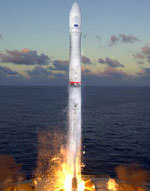
Image credit: Boeing
Sea Launch successfully launched Boeing-built Galaxy XIII/Horizons-1 satellite from the equator in the Pacific Ocean early this morning. A Zenit-3SL rocket lifted off from the launch platform at 0403 GMT (12:03am EDT) and carried the dual purpose satellite into orbit. A ground tracking station received signals from the satellite about an hour after launch, indicating that it was functioning normally and in the right trajectory to make its journey to geosynchronous orbit. It will eventually provide a variety of telecommunication services to North America.
Last night, a successful launch orbited Galaxy XIII/Horizons-1, a Boeing 601HP satellite built by Boeing [NYSE:BA] for PanAmSat Corporation, Wilton, Conn., and JSAT Corporation of Japan. The satellite will provide coverage over North America, Central America, Alaska and Hawaii from an orbital slot between the Hawaiian Islands and the U.S. west coast.
The 4,090 kg (8,998 lbs) satellite rocketed to geosynchronous transfer orbit aboard a Zenit-3SL provided by Sea Launch Company, LLC. Lift-off occurred at 9:03 p.m. PDT (4:03 a.m. GMT) from the Sea Launch Odyssey Launch Platform positioned on the equator in the Pacific Ocean. The spacecraft received its first signals at about 10:03 p.m. PDT at a ground station at Fucino, Italy, confirming normal operation.
?Communications satellites have erased the distance between the far corners of the globe,? said Dave Ryan, president of Boeing Satellite Systems International, a wholly owned subsidiary of Boeing. ?Galaxy XIII/Horizons-1 will continue that heritage as it also links the aspirations of PanAmSat and JSAT, who will use it to deliver trans-Pacific communications services. We are very proud to continue our legacy of teamwork with these two very important long time customers.?
Galaxy XIII/Horizons-1 with a final orbit slot at 127 degrees west longitude is the 207th Boeing-built commercial communications satellite launched to date. Forty years ago this year, the Boeing-built Syncom ushered in a revolution as the world?s first geosynchronous communications satellite.
Galaxy XIII/Horizons-1 will support PanAmSat?s domestic cable program distribution services as well as the Horizons international joint venture of PanAmSat and JSAT. The spacecraft will carry a total of 48 active transponders, 24 each in Ku-band and C-band. The Horizons partnership will use the spacecraft’s Ku-band payload, known as Horizons-1, to offer a variety of digital video, Internet and data services. In addition, the Ku-band payload on Galaxy XIII/Horizons-1 will be able to deliver content and services between the United States and Asia, using a teleport in Hawaii.
The C-band portion of the new spacecraft, known as Galaxy XIII, will be operated separately as part of PanAmSat’s Galaxy cable neighborhood, which serves the domestic U.S. cable industry. Galaxy XIII will be used to replace capacity on Galaxy IX, a Boeing 376 model that will move to a new orbital position and continue to provide services.
PanAmSat Corporation (NASDAQ:SPOT) is the premier provider of global video and data broadcasting services via satellite. For more information on PanAmSat, visit the company’s web site at www.panamsat.com. JSAT is a leading satellite operator in the Asia-Pacific region. For more information on JSAT, visit the company’s web site at www.jsat.net.
A unit of The Boeing Company, Boeing Integrated Defense Systems is one of the world’s largest space and defense businesses. Headquartered in St. Louis, Boeing IDS is a $25 billion business that provides systems solutions to its global military, government and commercial customers. It is a leading provider of intelligence, surveillance and reconnaissance; the world’s largest military aircraft manufacturer; the world’s largest satellite manufacturer and a leading provider of space-based communications; the primary systems integrator for U.S. missile defense; NASA’s largest contractor; and a global leader in launch services.
Original Source: Boeing News Release
